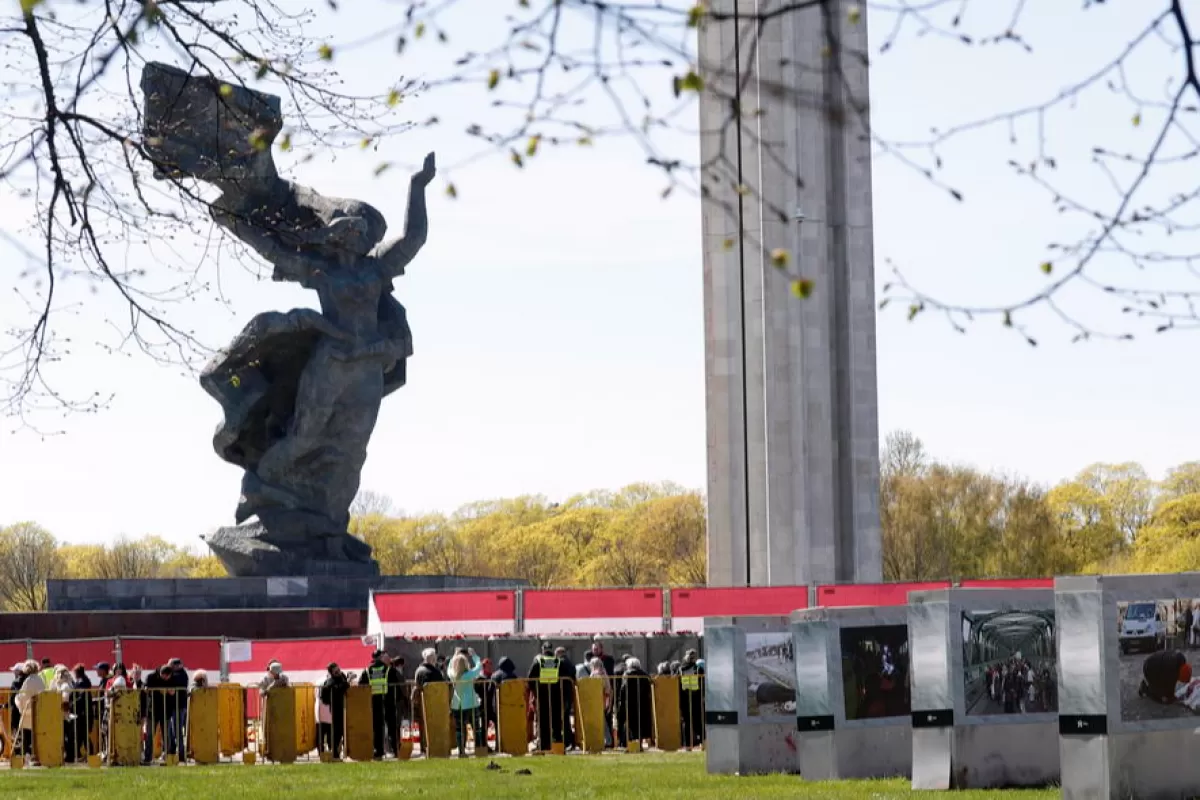
Respected and hated. Saw a lot of flowers, but was also cursed and even blown up. That’s the fate of the Monument of Victory in Riga which is, probably, going to be demolished as a consequence of Russia’s large scale invasion of Ukraine. Hundreds of other Soviet era monuments may soon follow
A symbol of liberation or occupation? The controversies surrounding the Victory monument
Today the monument of Victory is inaccessible. Despite the fact that it is located in one of the most well-known parks of Riga, next to major avenues crossed by thousands of cars, busses, and trams every day, nobody can reach it. It is surrounded by a fence guarded by the police 24/7.
Since it was first built, this monument has been regarded in many ways. While some part of the society sees it as a token of respect towards the Soviet Army and their soldiers who fell in Riga, in 1944, another part perceives it as a symbol of Soviet occupation and Russian modern imperialism. In the context of the Russian invasion of Ukraine, this monument became intolerable for many Latvians. According to a poll made by TNS, 65% of the population acknowledged that the monument of Victory must be demolished in one year at most. 35% of respondents said that the monument must stay where it is.
In 2022 the debate about the monument became so intense that after the 9th of May the police decided to close access to its location. The parliament and municipality of Riga decided that the monument must be demolished by the autumn. However, the whole process and the precise deadline are unknown.
The story of the monument embodies the opposite views on the role of the Soviet army and the Soviet Union in Latvia. During the Second World War, Latvia experienced three occupations. In 1940, the Soviets took over the country. One year later, after the Nazis unleashed operation Barbarossa, they took over the country. Then, in 1944 – 1945, the Soviet army gradually reclaimed control of the land, which then became part of the USSR until 1990. Riga, the capital of Latvia, came under the control of the Soviet Union on October 13th, 1944. According to official Soviet history – embraced to this day by Russia and some people in Latvia – the USSR brought freedom. According to Latvia’s official position, shared by a significant part of the country’s population, the “liberation” was just the beginning of the third occupation followed by the second deportation to Siberia in 1949 (the first one was in 1941) russification, etc.
The monument of Victory or, officially, the Monument to the Liberators of Soviet Latvia and Riga from the German Fascist Invaders, is dedicated to those Soviet soldiers who lost their lives in Riga in 1944.
However, the monument was built relatively recently – in 1985. It is in the park of Victory. In the center of the monument, there’s a 79 meters high obelisk. The monument also includes the image of the soldiers and the Motherland.
In June 1997, there was an illegal attempt by the officially prohibited Latvian organization „Perkonkrusts” to blow up the monument, but it was unsuccessful and two of the participants lost their lives.
Russia’s invasion of Ukraine spelled the end of the Victory monument
Normally, nobody pays any attention to this monument but one day in a year. However, during the last decade, the 9th of May became something more than just a remembrance of the Second World War. Initially it was about laying of flowers, concerts, fireworks, parades, wearing St. George’s ribbon and so on. Thousands of people participated. While some part of the population was happy to see a celebration of this scale, others left Riga on the 9th of May saying that it is impossible to see the celebrations of the Occupation.
The situation changed on the 24th of February 2022 when the Russian invasion started. The next day the base of the monument was painted with the colors of the Ukrainian flag and the debate about the fate of the monument started. Also, the 9th of May this year was different – first of all, there were significantly fewer people coming to celebrate, and secondly, around the monument there were a lot of Latvian and Ukrainian flags. People were not allowed to lay down flowers by themselves and had to be escorted to the monument. No concerts or parades were organized.
The next morning, the Riga municipality together with the police collected the flowers. But people were angered by the way it happened - by the tractor. A few hours later, many people laid flowers again, and unlike on the 9th of May, this time there were also Russian flags, war songs, and other symbols. The police watched it and did nothing, although it was forbidden to display these symbols in public. In the following days, those who opposed Russia's policy in Ukraine and saw what was happening as a threat to Latvia's independence were already offended and embarrassed. As a result, the minister of Interior affairs and some policemen lost their jobs.
Then people started to mobilize to tear down the monument. Some enterprises expressed their readiness to make a demolition project and to do the demolition itself for free. A fundraiser was started: everyone can donate the money for the demolition of the Monument of Victory. Until the 26th of June, almost 0.29 million EUR has been collected, given by almost 18 000 donors.
After the 9th and 10th of May, the politicians reacted as well. For instance, the Latvian parliament abolished the legal obstacles to the demolition of the monument, which were written in the Latvian-Russian agreement on the maintenance of monuments erected during the Soviet Union. These changes will not affect the maintenance of the Soviet soldier’s cemeteries. The Parliament stressed that the image of the Soviet Army and its symbols now are associated with the Russian army and their crimes against humanity in Ukraine.
However, not all the politicians agreed with this decision. For instance, MPs from the party “Harmony” that is regularly associated with Russia claimed that monuments are the evidence of history and they should not be demolished just because of the changes in the regime or other political principles.
The fate of Soviet monuments is tied to the war in Ukraine
There are 300 monuments or memorials dedicated to Soviet time in Latvia. Some have already been forgotten by the people and no one pays attention to them anymore, but many are still standing. In the second part of May around 5000 Latvians went to the streets in Riga asked for the demolition of Soviet monuments.
Riga is not the only place in Latvia where one must deal with what to do with the symbols of the past. And sometimes the solutions are pretty radical. Exactly one year before the massive attack on Ukraine, on February 24, 2021, Gundars Kalve, a local farmer, and father of a large family, dismantled a big, green metal cannon that was a part of a bigger monument of the Soviet Army in the Latvian city of Jekabpils located in the central part of the country. He did it arbitrarily, alone, in a long-planned operation.
Despite the fact that the cannon-monument was included in the list of burial sites protected by a bilateral agreement between Latvia and Russia in 2007, G. Kalve took it and dumped it in the largest river in Latvia - Daugava. He has been accused of desecrating the grave, which means a possible prison sentence of up to five years, as well as damaging trees in the park. Later, he voluntary confessed to the police. Now, G.Kalve is one of those Latvians who are fighting in Ukraine against Russia.
One more example is the monument of “Liberators of Rezekne” which was made on July 3, 1976, in honor of the 32nd anniversary of the city’s liberation from the Nazi conquerors. Rezekne is the second biggest city in the eastern part of Latvia. The municipality of the city has decided that the monument must be moved to the Brother’s Cemetery in Rezekne next to the cemetery of the Soviet soldiers. The municipality of Rezekne acknowledged that this decision has been made after the “exacerbation” of the geopolitical situation and before the potential provocations in the city.
Small towns are also affected by the change. In the village of Madliena, also located in the central part of Latvia, the monument dedicated to Soviet soldiers who according to the inscription written on the monument, “liberated Madliena from fascist conquerors” was demolished on the 26th of April. The monument – which was simply a large memorial stone – used to be in the center of the town, next to a church. Now it will be used in the construction of a road.
There has been a lot of talk about monuments in Latvia in recent months. The changes around these Soviet era relics are likely to continue for some time, and it is quite likely that their ultimate fate will be decided by events in Ukraine.


